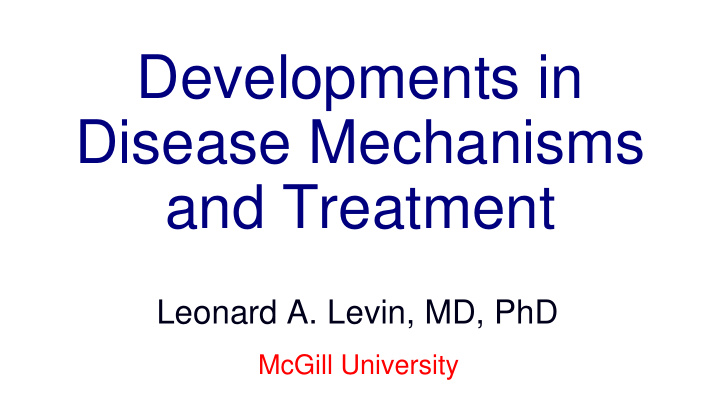



Developments in Disease Mechanisms and Treatment Leonard A. Levin, MD, PhD McGill University
Real-time imaging of single neuronal cell apoptosis in patients with glaucoma • Context – It would help if we could track RGC death in vivo in patients – Previous animal work demonstrating apoptotic RGC death can be imaged Cordeiro MF, Normando EM, Cardoso MJ, Miodragovic S, Jeylani S, Davis BM, Guo L, Ourselin S, A'Hern R, Bloom PA. Brain. 2017 Jun 1;140(6):1757-1767
Key Figure (Part 1)
Key Figure (Part 2)
Take-Home Message • ”… this is the first time individual neuronal apoptosis has been visualized in vivo in humans and is the first demonstration of detection of individual apoptotic cells in a neurodegenerative disease. • …our results suggest the level of apoptosis (‘DARC count’) is predictive of disease activity, indicating the potential of DARC as a surrogate marker.”
JUN is important for ocular hypertension- induced retinal ganglion cell degeneration • Context – The mechanisms that cause RGCs to die in disease are manifold – There is evidence that JUN-kinase is a key pro-death pathway – Is this true in the connection of high IOP and optic neuropathy? Syc-Mazurek SB, Fernandes KA, Libby RT. Cell Death Dis. 2017 Jul 20;8(7):e2945.
Key Figure 1
Key Figure 2
Take-Home Message • “… in glaucomatous neurodegeneration, JNK – JUN signaling has a major role as a pro-death signaling pathway between axonal injury and somal degeneration” • This is almost certainly relevant to optic neuropathies other than glaucoma
Targeting neuronal gap junctions in mouse retina offers neuroprotection in glaucoma • Context – It is unclear what leads to the spread of RGC death – Connexins make up gap junctions, through which toxic molecules can spread – Blocking the spread of toxins might be helpful for optic neuropathy Akopian A, Kumar S, Ramakrishnan H, Roy K, Viswanathan S, Bloomfield SA. J Clin Invest. 2017 Jun 30;127(7):2647-2661.
Key Figure 1
Key Figure 2
Take-Home Message • Blocking connexin 36 rescues RGCs, their axons, and their function in experimental glaucoma • “Neuronal GJs may thus represent potential therapeutic targets to prevent the progressive neurodegeneration and visual impairment associated with glaucoma” (and other optic neuropathies
Tonabersat prevents inflammatory damage in the central nervous system by blocking connexin43 hemichannels • Context – As in the previous paper, connexins can transmit toxic substances – Is this true for other retinal cells? Kim Y, Griffin JM, Nor MNM, Zhang J, Freestone PS, Danesh-Meyer HV, Rupenthal ID, Acosta M, Nicholson LFB, O'Carroll SJ, Green CR. Neurotherapeutics. 2017 Oct;14(4):1148-1165.
Key Figure
Take-Home Message • Blocking connexin 34 rescues photoreceptors in a light damage model • This is important because it was achieved with a pharmacological agent
Vitamin B 3 modulates mitochondrial vulnerability and prevents glaucoma in aged mice • Context – Mitochondria are part of the pathway by which RGCs and their axons die – Can mitochondrial modulation save RGCs in optic neuropathy? Williams PA, Harder JM, Foxworth NE, Cochran KE, Philip VM, Porciatti V, Smithies O, John SW. Science. 2017 Feb 17;355(6326):756-760
Key Figure
Take-Home Message • Increasing NAD levels rescues RGCs, their axons, and their function in experimental glaucoma • Although it is impractical to give such high doses of nicotinamide, it points the way to similar types of therapies
Axonal Degeneration in Retinal Ganglion Cells Is Associated with a Membrane Polarity-Sensitive Redox Process • Context – There is a natural occurring mutation (Wld S ) where RGC axons die slowly – How the axons are protected is unclear Almasieh M, Catrinescu MM, Binan L, Costantino S, Levin LA. J Neurosci. 2017 Apr 5;37(14):3824-3839
Key Figure (Part 1)
Key Figure (Part 2)
Take-Home Message • Slow axonal degeneration can be replicated with a small molecule drug • The mechanism is probably similar to that achieved in the experiments with nicotinamide in the previous paper
Sarm1 Deletion, but Not WldS, Confers Lifelong Rescue in a Mouse Model of Severe Axonopathy • Context – Perhaps there are other mutations where axonal degeneration is slowed Gilley J, Ribchester RR, Coleman MP. Cell Rep. 2017 Oct 3;21(1):10-16
Key Figure
Take-Home Message • “We therefore propose Sarm1 deletion as a more reliable tool than Wld S for investigating Wallerian-like mechanisms in disease models • SARM1 blockade may have greater therapeutic potential than WLDS-related strategies”
Axon Self-Destruction: New Links among SARM1, MAPKs, and NAD+ Metabolism • Context – Sarm1 deletion is a powerful inhibitor of axon degeneration – Does it also work through a redox mechanism? Gerdts J, Summers DW, Milbrandt J, DiAntonio A. Neuron. 2016 Feb 3;89(3):449-60
Key Figure 1
Key Figure 2
Take-Home Message • NAD+ depletion is central to axonal degeneration • Together, these papers suggest several ways of preventing axonal loss in optic neuropathies
The I-Just-Woke-Up Messages • We are close to being able to monitor actual RGC loss in our patients • We have several new strategies to help keep RGCs and their axons alive and decrease the spread of injury • This is relevant to optic nerve disease
Recommend
More recommend